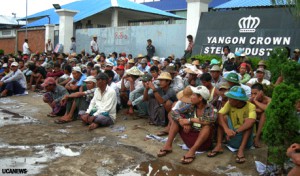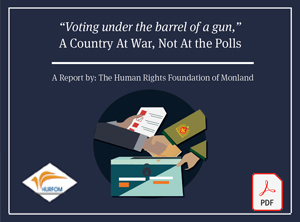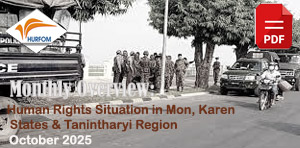Analyzing the New Labor Organization Law
June 14, 2012
A new labor law known as the Pyidaungsu Hluttaw Labour Organization Law No.7/2011 was signed and put into effect by President Thein Sein on March 9, 2012. International labor groups cautiously welcomed this new law for its commitment to giving workers the right to strike and negotiate with employers. However, some community labor leaders and activists claim that the state must reinforce the document’s promises by putting the law into practice. Other labor advocates and law experts highlight that the new law formalizes severe limitations intended to keep the country’s labor unions as weak as possible.
 In the wake of strikes held by Burmese workers from the Hlaing Thayar Industrial Zone and Tai Yi footwear factory due to dissatisfaction with current labor practices, it is essential to determine if this enacted law is indeed consistent with international labor law standards and whether it is incompatible with the country’s other existing domestic labor laws, namely those related to the conditions imposed on the formation of labor organizations. The following analysis explores some aspects of the new Labor Organization Law.
In the wake of strikes held by Burmese workers from the Hlaing Thayar Industrial Zone and Tai Yi footwear factory due to dissatisfaction with current labor practices, it is essential to determine if this enacted law is indeed consistent with international labor law standards and whether it is incompatible with the country’s other existing domestic labor laws, namely those related to the conditions imposed on the formation of labor organizations. The following analysis explores some aspects of the new Labor Organization Law.
Section 56 of the Labor Organization Law repeals the Labor Union Act of 1926. However, other labor-related laws remain active. There are no prescriptions to follow if this new Law and the Social Security Act prove to be in opposition.
If this enacted Law does not grant the freedom to organize like the repealed Labor Union Act of 1926 did, it would be tantamount to abolishing the International Labor Organization (ILO) Convention 87 that Burma signed in 1955 to protect the right to freely establish labor organizations. Also, in accordance with Convention 98, workers have the right to organize and jointly demand fair wages and job opportunities.
Section 55 (a) states that the Labor Ministry Department can issue “necessary” notifications, orders, directives, and procedures and may, with the approval of the Pyi Daung Su governing body, issue “necessary” rules, regulations, or by-laws.
In Burma, laws still exist that restrict the freedom to establish unions or labor organizations. The Unlawful Associations Act of 1908, Emergency Provisions Act of 1950, Printer and Publisher Registration of 1962, State Protection Law of 1975, and SLORC Law No. 6/88 on Forming of Organizations are all active laws that influence the establishment of labor organizations. There will only be absolute freedom to form organizations if all of these laws are repealed. Authentic freedom cannot be promised or enshrined in one law while others still inhibit individuals and organizations. These conflicting regulations render the enacted Labor Organization Law unlawful.
Under sections 36 and 37, no worker shall go on strike or initiate a lockout without giving at least 14 days advance notice to the relevant employer or conciliation body and may lockout or strike only after obtaining permission from the relevant parties.
In many countries, labor organizations do not have to provide prior notice to the employer that they plan to strike. This clause severely limits labor rights and is incompatible with workers’ freedom to organize and express their views.
According to section 40 (a) through (e), a lockout or strike will be considered illegal if it disrupts the provision of “essential services.” Additionally, “non-essential services” may “become” essential services based on subjective conditions including whether the strike or lockout is relevant to labor affairs, conforms to the manner originally permitted by the State, or is “out of proportion to the occupational interests of those involved.”
Section 41 states that if an illegal lockout or illegal strike is carried out, it will be banned in accordance with the Law, thereby threatening to block the freedom to organize labor activities using the four conditions laid out in section 40.
Under section 46 (a), no worker, for any dispute, shall go on strike for reasons born out of a dispute that is pending a trade dispute settlement.
Section 35 (a) states that the application to register as a labor organization shall be scrutinized by the Township Registrar in accordance with provisions contained in the law, and must subsequently be approved by the Chief Registrar. Section 34 allows a person not satisfied with application rejection orders given by the Chief Registrar to apply for the registration of the organization to the Supreme Court, or Pyi Daung Su Jury Member Body, in accordance with the Law.
True reformist labor law should not require complexity in registration, yet the application process has become more, not less, complicated. In July 1945, the well-known Burma Labor Union chairperson Takhin Lay Maung and general secretary Takhin Ba Tin did not have to register to establish the union.
It is useful to compare historical labor precedents in Burma to the current Labor Organization Law when assessing its value. For example, the rights and duties prescribed in its sections are not as comprehensive or clear as those of the Basic Rights and Duties of Public Labor of 1964. The social welfare provided during the Burma Socialist Program Party rule was lost under the SLORC and SPDC governments and never regained—hospital staff from Rangoon City and Thanhlayin Town will quickly agree.
The different classifications of Basic Labor Organization, Township Labor Organization, Region or State Labor Organization, Labor Federation, and Burma Labor Confederation prescribed in section 4 (a) through (e) of Chapter 2 are as onerous to comprehend as the steps required to form a Labor Council under the Burma Socialist Program Party. In response to those restrictions, a general labor protest took place on June 6, 1974, that demanded the repeal of the Labor Council policy. It is also useful to recall when the colonial government formed its Labor Policy and abolished the Labor Standard.
In conclusion, we should oppose this Law because it is designed to restrict and punish the working class and lacks conditions to uphold the rights of workers, their social welfare, and overall social development.
Comments
Got something to say?
You must be logged in to post a comment.




















































